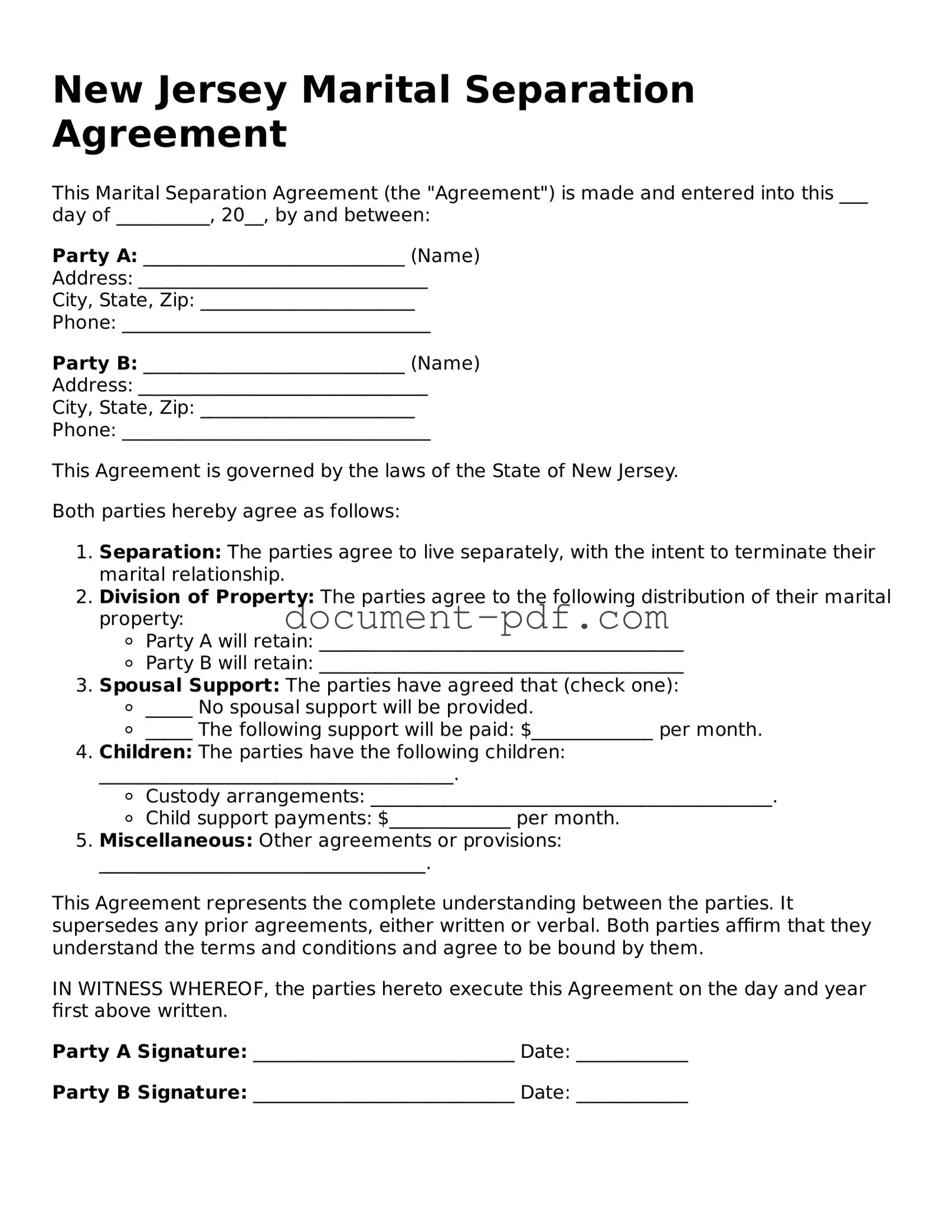The New Jersey Marital Separation Agreement is akin to a divorce settlement agreement. Both documents outline the terms and conditions that govern the dissolution of a marriage. A divorce settlement agreement typically includes provisions regarding asset division, child custody, and support obligations. While a marital separation agreement may serve as a temporary arrangement during a separation period, the divorce settlement agreement finalizes the terms after the legal dissolution of the marriage.
Another similar document is the Child Custody Agreement. This document specifically addresses the custody and visitation rights of parents regarding their children. It details the responsibilities of each parent and provides a framework for co-parenting. While the marital separation agreement may include child custody provisions, the child custody agreement focuses exclusively on the welfare and upbringing of the children involved.
The Property Settlement Agreement also shares similarities with the New Jersey Marital Separation Agreement. This document outlines how marital property will be divided between spouses. It specifies which assets belong to whom and may include real estate, bank accounts, and personal property. Both agreements aim to clarify the division of assets, but the property settlement agreement is often more detailed in its asset distribution provisions.
The Parenting Plan is another document that aligns closely with the New Jersey Marital Separation Agreement. This plan outlines how parents will raise their children after separation or divorce. It includes schedules for visitation, decision-making responsibilities, and communication methods between parents. While the marital separation agreement may touch upon parenting matters, the parenting plan is specifically designed to provide a comprehensive guide for child-rearing post-separation.
A Cohabitation Agreement also bears resemblance to the marital separation agreement. This document is used by couples who live together but are not married. It establishes the rights and responsibilities of each partner regarding property, finances, and other shared aspects of their lives. While the marital separation agreement deals with the dissolution of a marriage, the cohabitation agreement focuses on the terms of living together without formal marriage.
Understanding the importance of legal agreements, similar to a Property Settlement Agreement or a Divorce Agreement, is crucial for couples navigating separation or divorce. These documents help clarify expectations and responsibilities, ensuring both parties have a mutual understanding of their rights. For those in New York, resources such as New York PDF Docs can provide essential forms and guidance to aid in this complex process.
The Prenuptial Agreement is similar in that it outlines the terms of property and financial arrangements before marriage. This document can help clarify expectations and responsibilities, much like a marital separation agreement does during a separation. Both agreements seek to protect individual interests, although the prenuptial agreement is proactive, while the marital separation agreement is reactive to the dissolution of a marriage.
The Separation Agreement, often used interchangeably with the marital separation agreement, serves to formalize the terms of separation between spouses. It addresses issues such as support, custody, and property division. Both documents aim to provide clarity and structure during a difficult transition, though the separation agreement may not necessarily lead to divorce.
The Financial Disclosure Statement is another relevant document. This statement provides a comprehensive overview of each spouse's financial situation, including income, debts, and assets. While the marital separation agreement may reference financial obligations, the financial disclosure statement serves as a detailed account that informs the terms of the separation agreement.
Lastly, the Mediation Agreement is similar in its collaborative approach to resolving disputes. This document is created when couples engage in mediation to settle their differences amicably. It outlines the agreements reached during mediation, including issues related to custody and financial arrangements. Like the marital separation agreement, the mediation agreement aims to facilitate a peaceful resolution, though it often results from a structured negotiation process.
